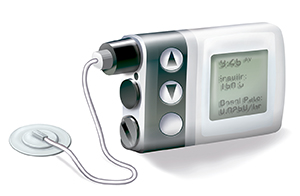Diabetes and Your Child: Considering an Insulin Pump
Your child has diabetes. They need to be given a hormone called insulin. Insulin helps to give your child’s cells the energy they need to work. Insulin is most often given by shot. This is done with a needle and syringe. Most children with diabetes need several shots each day.
A device called an insulin pump can also be used to give insulin. A pump may help reduce the number of shots your child needs. An insulin pump can give you more choices about your child’s treatment plan. Many parents and children find that an insulin pump helps improve blood sugar control over time.
But pumps do have some drawbacks. Your child’s healthcare provider can help you decide if an insulin pump is a good choice. There are different kinds of pumps. The healthcare provider can help you understand how each kind works.
 |
| An insulin pump is about the size of a pager or cell phone. It can be easily worn beneath your child’s clothing. |
How an insulin pump works
An insulin pump is a small device. It's about the size of a cell phone. Insulin is sent from the pump to the body through a thin plastic tube. The tube is attached to a soft, flexible tube called a cannula. The cannula is put under the skin.
The pump can give a steady dose of insulin. This is called a basal dose. It acts like the body’s natural release of insulin. The pump can also give a single dose. This can be given before meals. Or it can be done to correct high blood sugar. This is called a bolus dose.
The pump is worn all the time, day and night. It is easily hidden under loose clothing. Or it can be clipped to a waistband or belt. But it can be disconnected for a short time for taking a bath or shower.
Benefits of an insulin pump
Some of the benefits of an insulin pump include:
-
It reduces the number of shots needed (good if your child is afraid of needles).
-
Doses of insulin can be given more accurately than with shots.
-
It acts more like the body’s natural release of insulin than shots.
-
It allows for both quick and around-the-clock delivery of insulin.
-
It gives your child more freedom in what and when they eat than shots.
-
It may lead to fewer extreme highs and lows than shots.
-
It may improve your child’s A1C number.
Risks of an insulin pump
There are also some risks of the pump. These include:
-
It may not improve your child's blood sugar numbers.
-
Blood sugar may need to be checked more often than with shots.
-
Ketones may need to be checked more often than with shots. Your child’s healthcare provider will teach you how to check for ketones.
-
The pump may be visible to others, which your child may not like.
-
It may not be covered by health insurance.
-
It may raise your child’s risk of weight gain and infections.
-
It may raise your child's risk of diabetic ketoacidosis (DKA) if the pump or tube stops working. See "Understanding the risk of diabetic ketoacidosis (DKA)" below.
Other things to know
An insulin pump can be used with a child of any age, even a baby. To help decide if a pump is right for your child, think about these things:
-
Counting carbs will be more important than with shots.
-
Your child may still need frequent blood sugar checks.
-
You’ll need to keep careful records of your child’s blood sugar readings.
-
Single doses of insulin must still be given before meals.
-
You must closely watch your child for high or low blood sugar symptoms.
-
An older child must be interested in the pump and willing to wear it.
-
You and your child need special training. Both you and your child must commit to learning how the pump works and how to use it safely.
-
You must work closely with your child’s school to make sure your child’s diabetes care is supervised.
-
You will need a back-up person trained to manage the pump in case of an emergency.
Understanding the risk of diabetic ketoacidosis (DKA)
Diabetic ketoacidosis (DKA) is a serious condition that can happen if your child doesn’t get needed insulin. It can lead to a coma. Sometimes it can even lead to death. If the insulin pump stops working, DKA could happen soon after.
-
Talk about the risks of DKA with your child’s healthcare provider.
-
Learn what to do if the pump fails for any reason.
-
Watch your child’s blood sugar closely. This is the only way to be sure that they are getting needed insulin.
-
Always keep diabetes supplies close by.
-
Be ready to give your child an insulin shot right away if needed.
To learn more
For more information about diabetes, visit these websites:
Note
This sheet does not give all the information you need to care for your child with diabetes. Ask your child’s healthcare provider for more information.